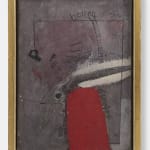David Hockney b. 1937
Heaven Perpendicular, c1960-61
oil and sand on canvas
15 1/4 x 11 1/4 inches
38.9 x 28.7 cm
38.9 x 28.7 cm
Heaven Perpendicular is one of an important series of highly imaginative and personal compositions that David Hockney painted while he was a student at the Royal College of Art. Initially,...
Heaven Perpendicular is one of an important series of highly imaginative and personal compositions that David Hockney painted while he was a student at the Royal College of Art. Initially, when he enrolled on the painting course, Hockney had focused his attention on making large, purely abstract paintings on 3 by 4 foot hardboard, inspired by Abstract Expressionist painting, which had recently travelled over from America by way of the influential exhibitions Modern Art in the United States (1956) and New American Painting (1959) at the Tate, and the Jackson Pollock retrospective at the Whitechapel Gallery (1958). However, prompted by fellow student R.B. Kitaj, it was not long before Hockney moved away from pure abstraction and began to explore more personal themes within his work. Executed on a more intimate scale than the artist’s previous abstract experiments, Heaven Perpendicular reflects this transition, its small size enticing the viewer closer to the canvas surface, which on inspection reveals itself to be a thick, dry mixture of oil paint and sand. Largely due to the encouragement of American student at the college,
Mark Berger, Hockney opened up about his homosexuality, which was still illegal in Britain at this time.1 He went on to explore what was then a ‘taboo’ subject in a series of paintings which celebrated his sexuality in a veiled way, through a series of coded signs and abbreviations. Paintings such as the present work, Going to be a Queen for Tonight, 1960 (Royal College of Art, London), Study for Doll Boy, 1960 (Tate, London), The Third Love Painting, 1960 (Tate, London) and We Two Boys Together Clinging, 1961 (Arts Council, England) are now considered Hockney’s ‘coming out’ statements.
In this painting, there are a number of sexual metaphors; the red form of the figure’s body rising up from the bottom edge of the canvas that unmistakably resembles a phallus, the keyhole placed close to the figure’s behind, and the scrawled words ‘Heaven’ and ‘Perpendicular’, a poetic reference to an erection (the subject and title of another painting from 1959 – 60). As in numerous other works from this period, Peter Crutch, Hockney’s unrequited crush at the time, appears to be the subject of this painting, his name referenced here by way of a letter ‘P’ floating next to the figure’s head.
The imagery, gestural brushwork and dry paint surface of the present work all strongly correspond to the formal vocabulary of Alan Davie’s Discovery of the Staff from 1957, a painting Hockney had seen in 1958. Stylistically, the painting also reflects the artist’s interest in the work of Jean Dubuffet, who was himself inspired by children’s art. The ‘ladder’ could also be interpreted as a spine, recalling the skeleton drawings that Hockney made in his first term as a student, or as a guitar, reminiscent of those in the Cubist paintings of Picasso and Braque.
1 Homosexuality was not decriminalised in Britain until as recently as 1967
Mark Berger, Hockney opened up about his homosexuality, which was still illegal in Britain at this time.1 He went on to explore what was then a ‘taboo’ subject in a series of paintings which celebrated his sexuality in a veiled way, through a series of coded signs and abbreviations. Paintings such as the present work, Going to be a Queen for Tonight, 1960 (Royal College of Art, London), Study for Doll Boy, 1960 (Tate, London), The Third Love Painting, 1960 (Tate, London) and We Two Boys Together Clinging, 1961 (Arts Council, England) are now considered Hockney’s ‘coming out’ statements.
In this painting, there are a number of sexual metaphors; the red form of the figure’s body rising up from the bottom edge of the canvas that unmistakably resembles a phallus, the keyhole placed close to the figure’s behind, and the scrawled words ‘Heaven’ and ‘Perpendicular’, a poetic reference to an erection (the subject and title of another painting from 1959 – 60). As in numerous other works from this period, Peter Crutch, Hockney’s unrequited crush at the time, appears to be the subject of this painting, his name referenced here by way of a letter ‘P’ floating next to the figure’s head.
The imagery, gestural brushwork and dry paint surface of the present work all strongly correspond to the formal vocabulary of Alan Davie’s Discovery of the Staff from 1957, a painting Hockney had seen in 1958. Stylistically, the painting also reflects the artist’s interest in the work of Jean Dubuffet, who was himself inspired by children’s art. The ‘ladder’ could also be interpreted as a spine, recalling the skeleton drawings that Hockney made in his first term as a student, or as a guitar, reminiscent of those in the Cubist paintings of Picasso and Braque.
1 Homosexuality was not decriminalised in Britain until as recently as 1967
Provenance
Eduardo ArroyoGrazia Eminente
Exhibitions
Wakefield, The Hepworth Wakefield, Alan Davie & David Hockney: Early Works, 19 October 2019 – 19 January 2020, ex catalogue



